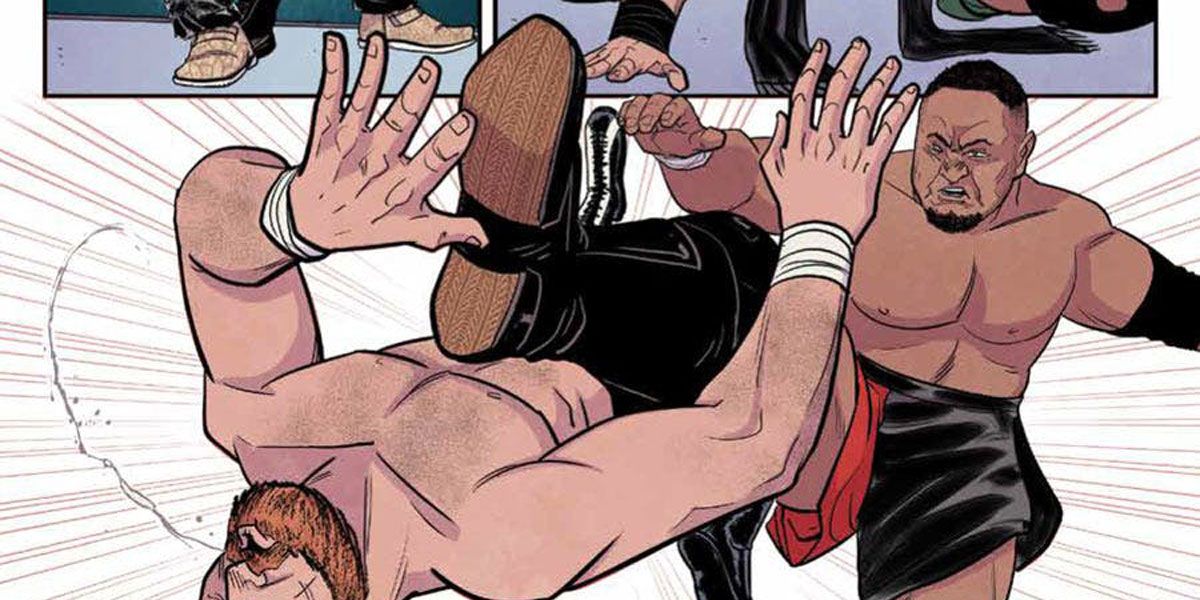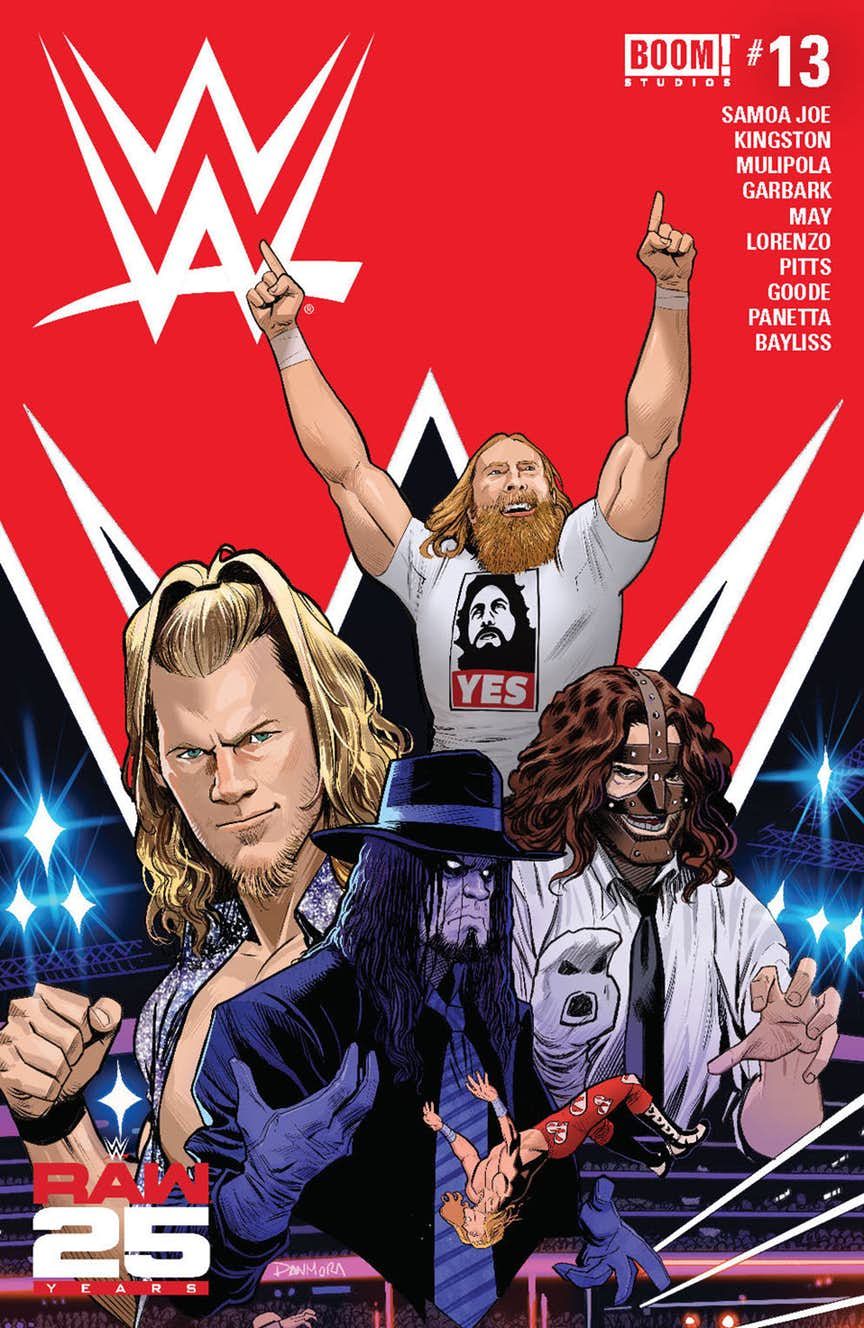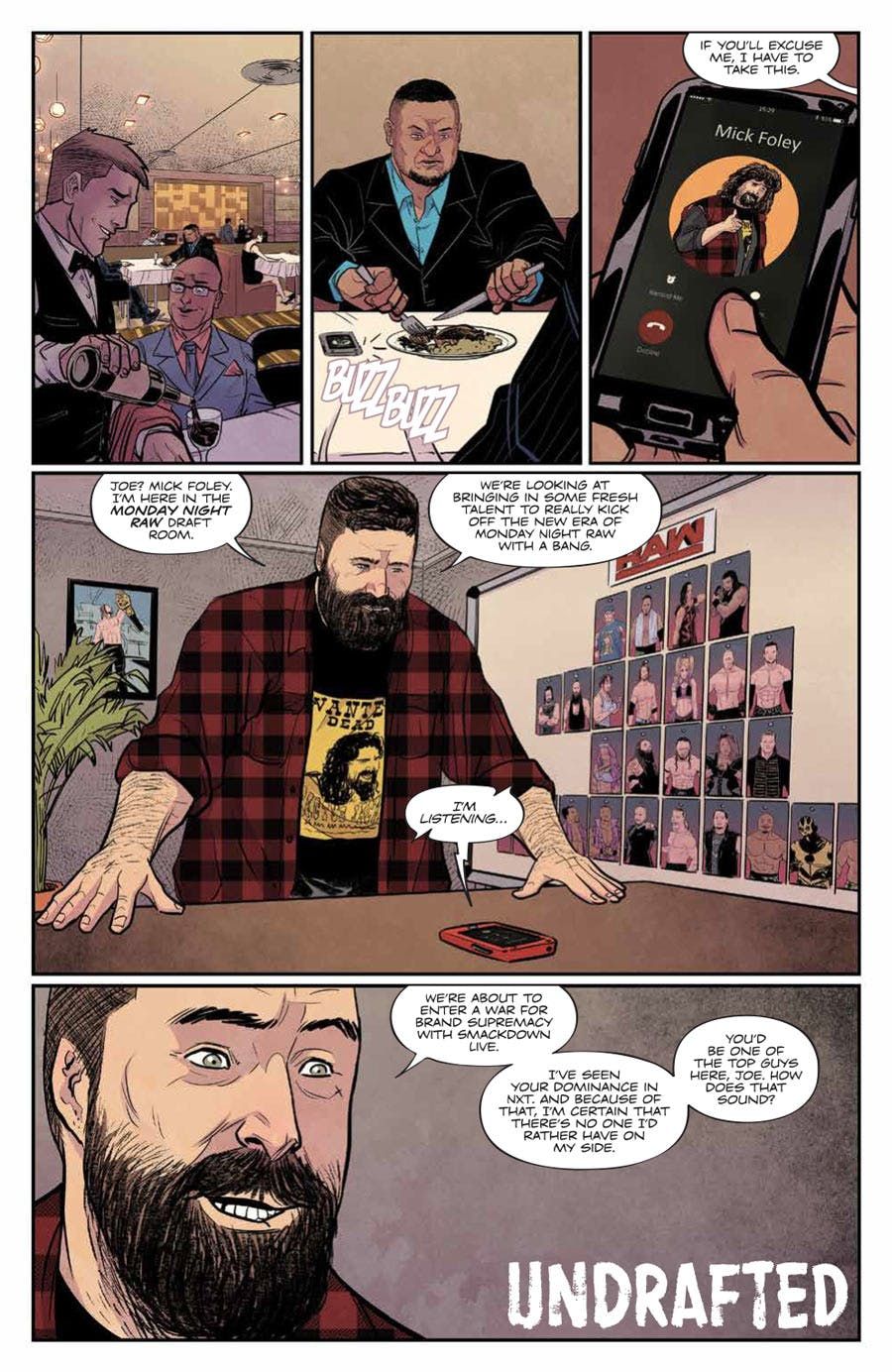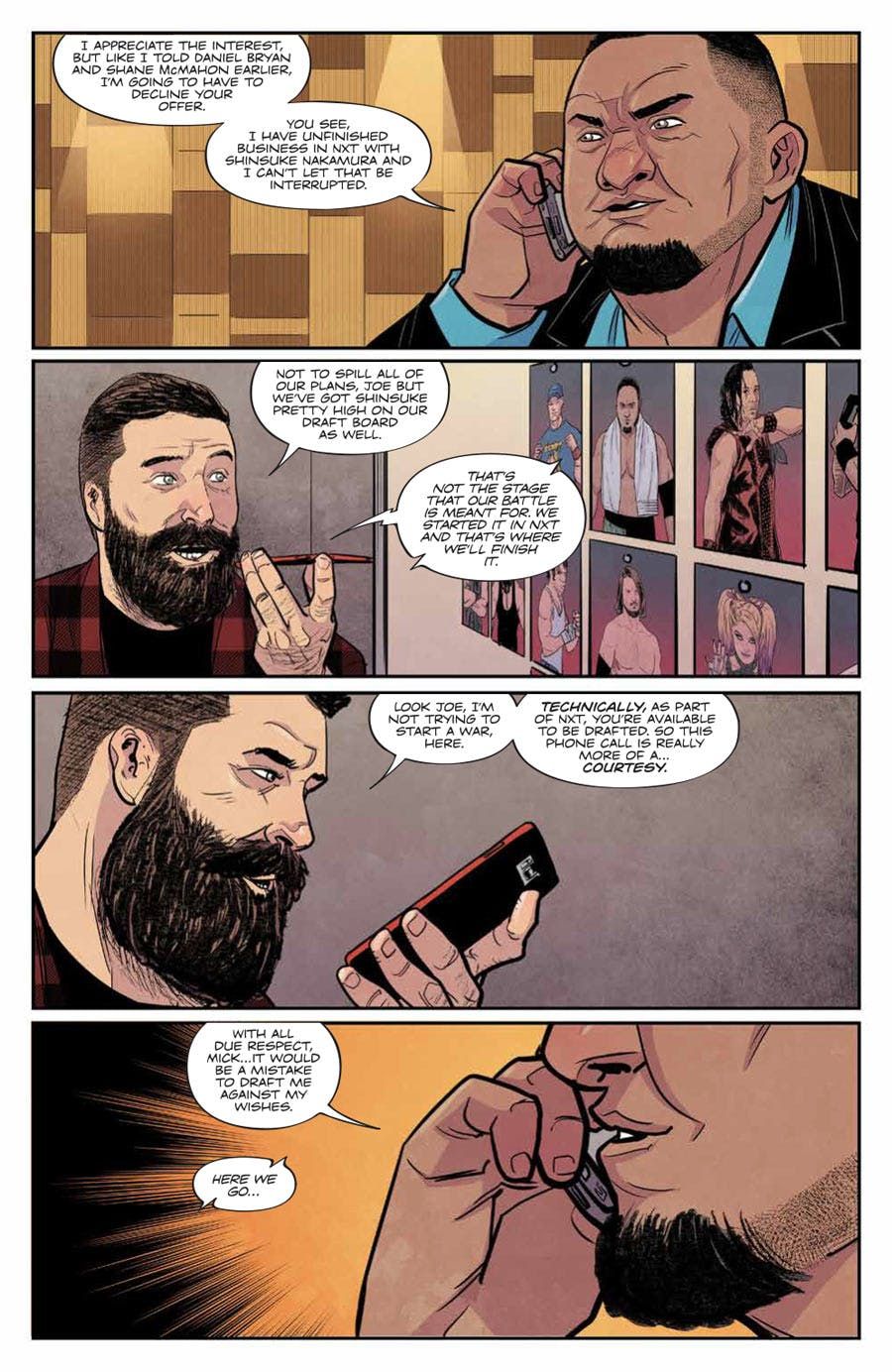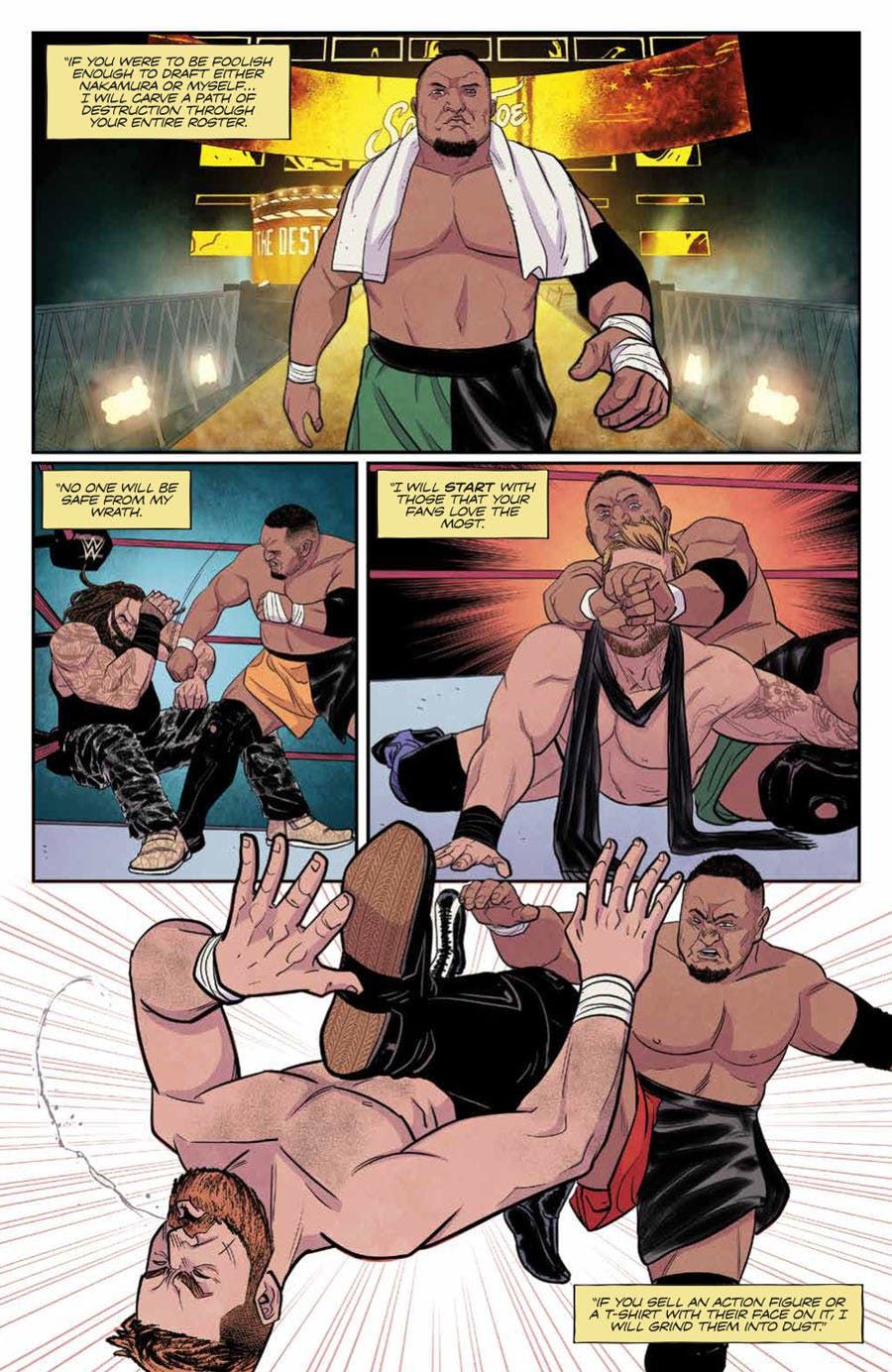For more than a decade, Samoa Joe stood as one of the most acclaimed and formidable professional wrestlers to never set foot in a WWE ring. (Other than a one-shot 2001 match on little-seen program "WWF Jakked.") Known for his lengthy runs in Ring of Honor and Total Nonstop Action Wrestling, Joe joined WWE's NXT roster in May 2015, and helped bring that buzzworthy brand to its current prominence -- leading to a long-awaited debut on WWE's premier series, Raw, in January 2017.
RELATED: WWE #13 Preview
The story of how that came to be -- a version of it, at least -- is told in issue #13 of BOOM! Studios' WWE comic book, on sale this week. And it's told by no less of an authority than Joe himself, co-writing the story with Headlocked creator Mike Kingston, with art by Headlocked regular artist, Michel Mulipola. Joe, Kingston and Mulipola present a streamlined, fictionalized version of Joe's journey from NXT to Raw that incorporates real-life and storyline elements, including WWE Hall of Famer Mick Foley advocating for Joe to join WWE, and Joe's NXT feud with Shinsuke Nakamura.
Co-writing a comic book story was a natural fit for Samoa Joe, who describes himself as a lifelong fan of the medium. CBR spoke with both Joe and Kingston about the story in WWE #13, including Joe's comic book fandom and future ambitions, and Kingston's history of collaborating with pro wrestlers -- such as co-writing a story with current WWE Champion AJ Styles in BOOM! Studios' freshly released WWE Royal Rumble 2018 Special one-shot.
CBR: Joe, let's start broadly with you and comic books -- I've heard for years that you're a comics fan, and you've worked with Mike Kingston before. What can you share about your passion for comics, and what motivated you to try your hand at writing them?
Samoa Joe: I've had a lifelong love for comics. I was fortunate that I was born in an era where comic books kind of grew up with me. Obviously, when you're younger you gravitate more towards superhero titles. But I lived through the big Image revolution -- being a young kid, owning every variant cover of WildC.A.T.S. you could possibly find out there, all that gold foil embossed, all the madness. "I'm going to be a millionaire, and this is going to be my life's savings!"
And then later on to now, discovering so many great books over the years, especially a lot of graphic novels. I'm a notorious [trade paperback] hound -- if I get an opportunity to visit a publisher, I'm always harping on, "Just give me the trades." "You don't want the single issues?" I like the stories. The collecting's cool, but I'm more about the stories.
Comics were an easy way, before eBooks, when my career started -- I could throw a couple trades in a backpack when I was going on the road to wrestle. That was a weekend of free time reading that was pretty invaluable, especially when you travel internationally, or you're out and about in new cities where you don't know a lot about the area. Sitting in a hotel room and having a couple of great trades to pass the time really helped the work go a little bit smoother.
How did you get involved in the WWE comic and arrive at telling this story, on making the jump from NXT to Raw -- and why it didn't happen earlier than it did?
The story that I worked on with Mike is kind of an amalgamation. It's funny, it happens in a short amount of time in the book, but really, it's bits and pieces taken from almost over a decade of instances and occurrences that ended up leading me to be on Raw.
The NXT stuff -- it was quite simple. My first remit when I came to WWE was to help build up NXT as a global brand. It was a mission that I took on fully, and was more than willing to attack, and lo and behold, here we are. Now NXT is a third touring brand for WWE. We sold out Wembley Arena twice. Now NXT is the quintessential third brand of WWE, and it's still growing. To be on the forefront of that is awesome. Really, that was the basic reason why it took a little bit longer, technically, for me to get to the Raw and SmackDown! rosters. And I had no problem with it -- I was very, very excited about the opportunity, and I'm glad that we accomplished what we accomplished.
It was a cool experience putting it together. Mike -- I've worked with him before, he's got a tremendous respect and a mind for wrestling, and he's a great writer.
Let's talk about the artist in the story, Michel Mulipola. That's a tough task, illustrating real people that the audience will recognize, and capturing the motion inherent in pro wrestling. What do you like about what he did with the art?
I met him years ago -- he had actually drawn me, and sent me a piece on Twitter. Mike had gotten in touch with me, and said, "This guy's my artist, he's awesome." I remember the first time I saw the art. He has a really great knack of taking real characters that people see every week -- which is I think sometimes the hardest subject matter to draw, because you are held to a visual standard that people are accustomed to, week in and week out -- and then translating it into the comic book style. He really does a fantastic job of it. I've been blown away by the art, but then again, I'm blown away by the art he's done, regardless. It was just really cool to have myself immortalized between the panels of a book.
In reality, you just don't see many Samoan artists. Culturally, it's just not something that's really emphasized much; at least hand-drawn art. You'll find Samoan families push their kids into music, maybe literature, but to see Mike as such a talented artist that's put out such great work, and to be a part of the process of creating this book, it's really, really cool.
What ambitions do you have in comics? Do you plans to keep exploring comics writing as your schedule allows?
I will say this: Any further forays into comics, I definitely want to do a little bit more studying. I've been fortunate enough that being around comics all my life, and knowing a lot of great artists and great writers, and knowing the work and the effort they put into it just to be published -- I'd hate to use my celebrity just to pry my way in. I'd love for something that I write to actually be accepted. Maybe it's even writing under a pseudonym, I don't know.
If I do foray more into writing comic books, I definitely would hope that my acceptance is based more on my ability to write than my ability to schmooze my way in as a celebrity. [Laughs]
Your WWE comics story is about transitioning from NXT to Raw -- and this month marks a year that you've been on the Raw roster. What has this phase of your career been like? You had achieved a tremendous amount before that, but this has to be a different level.
It's funny. I tell this to a lot of people who ask me this -- if I were to have stopped wrestling a year ago, I would have said I had a fantastic career. A very, very fulfilling career. And I think most people would agree with me. But I've found myself here on Raw, and I'm literally living in the bonus.
This year's been absolutely fantastic -- a lot of high points, a lot of milestones. Being a part of the Raw crew and WWE -- I think now I appreciate it more than I would have [earlier], only because I've experienced pretty much every other scenario working in this industry outside of WWE. To be here now, it's very fun for me, and honestly, it's very enjoyable, because I'm at a point in my career now where I can go out there, I'm confident in what I can do, I'm confident in what I have to offer, and WWE has been very confident in letting me do what I do. It's a very fun, mutual relationship that we have going so far.
You mentioned the comics you've been reading -- any recent favorites?
The Lewis and Clark one put out by Skybound -- Manifest Destiny. I've been reading a lot of Manifest Destiny.
Page 2: [valnet-url-page page=2 paginated=0 text='Keep reading to hear from Headlocked creator Mike Kingston on his WWE stories']
CBR: Mike, between Headlocked and these two WWE stories at BOOM! Studios, you've collaborated extensively with pro wrestlers on comic book stories. What has it meant for you in your storytelling to get the insight that level of authenticity provides?
Mike Kingston: These guys are all storytellers. I’ve been in locker rooms and watched guys put matches together, I’ve been in cars driving between shows and listened to them. I remember being out for dinner at [Comic-Con International in San Diego] years ago with Paul Heyman, Christopher Daniels and Shane Helms. I had started to tell a story and Paul stopped me halfway through and told me how I was telling it wrong. If you keep your ears open, you can’t help but learn.
Both of these WWE stories present fictionalized versions of real-life events. What was it like shaping both of these stories? How did you and your co-writers arrive at these being the two stories to tell?
Producing 52 weeks of live programming, adjusting to injuries... sometimes every beat of a story doesn't appear on TV. These are the types of things that I love writing, what we haven't seen. With AJ, we tied together his early runs and with Joe, we explain why he and Nakamura weren’t drafted during the Superstar Shakeup.
As someone who is intimately involved in the intersection of comic books and pro wrestling, what do you think the current WWE series doing that has helped it succeed where other licensed wrestling comics may have stumbled?
I definitely think telling stories about wrestling is important, and I think it's great that the stories in the current WWE series focus on in-ring action.
RELATED: INTERVIEW: AJ Styles’ ‘Phenomenal’ Story in WWE Royal Rumble Special
Much has been made about the connections between comics and pro wrestling. How do you see that as playing into pro wrestlers being uniquely suited to try their hands at comic book storytelling?
As I mentioned earlier, wrestlers are natural storytellers. They tell stories in the ring, on the road in between towns, and in bars after the shows. Sit down with any of them and in no time, the stories start flowing. In these issues specifically, both Joe and AJ are all the way down with geek culture, so there’s an enthusiasm there that helps make it something special.
With the Samoa Joe story, you reteamed with Michel Mulipola, who you've worked with on Headlocked. The AJ story is illustrated by Daniel Bayliss, a BOOM! Studios veteran. For you, what qualities make an artist uniquely suited to take on a pro wrestling story?
Michel, my co-creator on Headlocked, is an actual wrestler (as is Andy Belanger)... but ultimately, I just think it takes passion and understanding. It can be difficult trying to explain to someone who doesn’t dig on wrestling what certain moves are and how things should look. All the YouTube clips in the world can’t help a non-fan translate the uniquely kinetic energy involved in a hurricanrana.
WWE #13, featuring creators including Mike Kingston, Kevin Panetta, Samoa Joe, Julian May, Lan Pitts, Kendall Goode, Michael Mulipola, Rodrigo Lorenzo and Daniel Bayliss, is scheduled for release on Wednesday, Jan. 17.

